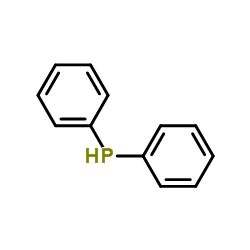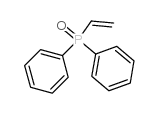1,2-bis(diphenylphosphino)ethane monooxide

1,2-bis(diphenylphosphino)ethane monooxide structure
|
Common Name | 1,2-bis(diphenylphosphino)ethane monooxide | ||
|---|---|---|---|---|
| CAS Number | 984-43-0 | Molecular Weight | 414.41600 | |
| Density | N/A | Boiling Point | 534.306ºC at 760 mmHg | |
| Molecular Formula | C26H24OP2 | Melting Point | 195-199ºC(lit.) | |
| MSDS | Chinese USA | Flash Point | 276.938ºC | |
| Name | 1,2-bis(diphenylphosphino)ethane monooxide |
|---|---|
| Synonym | More Synonyms |
| Boiling Point | 534.306ºC at 760 mmHg |
|---|---|
| Melting Point | 195-199ºC(lit.) |
| Molecular Formula | C26H24OP2 |
| Molecular Weight | 414.41600 |
| Flash Point | 276.938ºC |
| Exact Mass | 414.13000 |
| PSA | 40.47000 |
| LogP | 5.13340 |
| Appearance of Characters | Powder | white |
|
Section 1: Product Identification Chemical Name:1,2-Bis(diphenylphosphino)ethane monooxide, min. 97% CAS Registry Number:984-43-0 Formula:(C6H5)2PCH2CH2P(O)(C6H5)2 EINECS Number:none Chemical Family:organophosphine ligand Synonym:[2-(Diphenylphosphino)ethyl]diphenylphosphine oxide; [2-(Diphenyl-phosphinoyl)-ethyl]-diphenyl-phosphane
Section 2: Composition and Information on Ingredients IngredientCAS NumberPercentACGIH (TWA)OSHA (PEL) Title compound984-43-0100%no datano data Section 3: Hazards Identification Emergency Overview:Irritating to skin, eyes and respiratory tract. May be harmful if swallowed. Primary Routes of Exposure:Inhalation, skin, eyes. Eye Contact:Causes moderate irritation of the eyes. Skin Contact:Causes irritation of the skin. May cause redness, itching and pain. Inhalation:Irritating to the nose, mucous membranes and respiratory tract. Ingestion:No specific information is available on the physiological effects of ingestion. May be harmful if swallowed. Acute Health Affects:Irritating to skin, eyes and respiratory tract. Chronic Health Affects:No information on long-term chronic effects. NTP:No IARC:No OSHA:No SECTION 4: First Aid Measures Immediately flush the eyes with copious amounts of water for at least 10-15 minutes. A victim may need Eye Exposure: assistance in keeping their eye lids open. Get immediate medical attention. Wash the affected area with water. Remove contaminated clothes if necessary. Seek medical assistance if Skin Exposure: irritation persists. Remove the victim to fresh air. Closely monitor the victim for signs of respiratory problems, such as difficulty Inhalation: in breathing, coughing, wheezing, or pain. In such cases seek immediate medical assistance. Seek medical attention immediately. Keep the victim calm. Give the victim water (only if conscious). Induce Ingestion: vomiting only if directed by medical personnel. SECTION 5: Fire Fighting Measures Flash Point:no data Autoignition Temperature:no data Explosion Limits:no data Extinguishing Medium:carbon dioxide, dry powder or foam If this product is involved in a fire, fire fighters should be equipped with a NIOSH approved positive pressure Special Fire Fighting Procedures: self-contained breathing apparatus and full protective clothing. Hazardous Combustion andIf involved in a fire this material may emit toxic organic fumes. Decomposion Products: Unusual Fire or Explosion Hazards: No unusual fire or explosion hazards. SECTION 6: Accidental Release Measures Spill and Leak Procedures:Small spills can be mixed with vermiculite or sodium carbonate and swept up. SECTION 7: Handling and Storage Handling and Storage:Store the material in a cool, dry place in a tightly sealed container. SECTION 8: Exposure Controls and Personal Protection Eye Protection:Always wear approved safety glasses when handling a chemical substance in the laboratory. Skin Protection:Wear protective clothing and gloves. Ventilation:Handle the material in an efficient fume hood. If ventilation is not available a respirator should be worn. The use of respirators requires a Respirator Respirator: Protection Program to be in compliance with 29 CFR 1910.134. Ventilation:Handle the material in an efficient fume hood. Additional Protection:No additional protection required. SECTION 9: Physical and Chemical Properties Color and Form:white powder Molecular Weight:414.42 Melting Point:no data Boiling Point:no data Vapor Pressure:no data Specific Gravity:no data Odor:not determined Solubility in Water:no data SECTION 10: Stability and Reactivity Stability:air and moisture stable Hazardous Polymerization:no hazardous polymerization Conditions to Avoid:none Incompatibility:strong oxidizing agents and halogens Decomposition Products:carbon monoxide, carbon dioxide, phosphorous pentoxide, and organic fumes. SECTION 11: Toxicological Information RTECS Data:No information available in the RTECS files. Carcinogenic Effects:no data Mutagenic Effects:no data Tetratogenic Effects:no data SECTION 12: Ecological Information Ecological Information:No information available SECTION 13: Disposal Considerations Disposal:Dispose of according to local, state and federal regulations. SECTION 14: Transportation Shipping Name (CFR):Non-hazardous Hazard Class (CFR):NA Additional Hazard Class (CFR):NA Packaging Group (CFR):NA UN ID Number (CFR):NA Shipping Name (IATA):Non-hazardous Hazard Class (IATA):NA Additional Hazard Class (IATA):NA Packaging Group (IATA):NA UN ID Number (IATA):NA SECTION 15: Regulatory Information TSCA:Not listed in the TSCA inventory. SARA (Title 313):Title compound not listed. Second Ingredient:none SECTION 16 - ADDITIONAL INFORMATION N/A |
| Personal Protective Equipment | Eyeshields;Gloves;type N95 (US);type P1 (EN143) respirator filter |
|---|---|
| Safety Phrases | S22-S24/25 |
| RIDADR | NONH for all modes of transport |
| WGK Germany | 3 |
| HS Code | 2902909090 |
|
~84% 
1,2-bis(dipheny... CAS#:984-43-0 |
| Literature: Grushin, Vladimir V. Journal of the American Chemical Society, 1999 , vol. 121, # 24 p. 5831 - 5832 |
|
~88% 
1,2-bis(dipheny... CAS#:984-43-0 |
| Literature: Kabachnik, M. I.; Medved', T. Ya.; Pisareva, S. A.; Ignat'eva, T. I.; Lomakina, L. N.; et al. Bulletin of the Academy of Sciences of the USSR, Division of Chemical Science (English Translation), 1980 , vol. 29, # 3 p. 495 - 500 Izvestiya Akademii Nauk SSSR, Seriya Khimicheskaya, 1980 , # 3 p. 673 - 678 |
|
~84% 
1,2-bis(dipheny... CAS#:984-43-0 |
| Literature: Petersson, Maria J.; Loughlin, Wendy A.; Jenkins, Ian D. Chemical Communications, 2008 , # 37 p. 4493 - 4494 |
|
~89% 
1,2-bis(dipheny... CAS#:984-43-0 |
| Literature: Bondarenko, N. A.; Rudomino, M. V.; Tsvetkov, E. N. Bulletin of the Academy of Sciences of the USSR, Division of Chemical Science (English Translation), 1990 , vol. 39, # 9.2. p. 1989 Izvestiya Akademii Nauk SSSR, Seriya Khimicheskaya, 1990 , vol. 39, # 9 p. 2180 - 2181 |
| HS Code | 2902909090 |
|---|---|
| Summary | 2902909090 other aromatic hydrocarbons。Supervision conditions:None。VAT:17.0%。Tax rebate rate:9.0%。MFN tariff:2.0%。General tariff:30.0% |
| Tetraphenylethylenediphosphine monooxide |
| AURORA KA-1612 |
| tetraphenylethylenediphosphine monoxide |
| MFCD00345406 |




